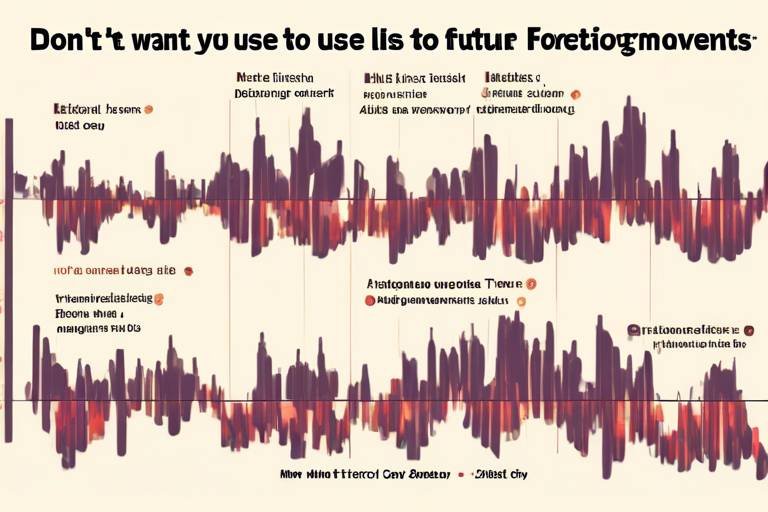How to Analyze Price Movements Using Chart Patterns
In the fascinating world of trading, understanding how to analyze price movements is crucial for making informed decisions. One of the most powerful tools at a trader's disposal is chart patterns. These visual representations of price movements can provide invaluable insights into market behavior, helping traders predict future price actions with a degree of confidence. So, how do we dive into the depths of these patterns? Let’s explore the significance of chart patterns in financial analysis and outline key techniques to interpret them effectively.
Chart patterns are essentially the fingerprints of market sentiment. They reveal the underlying psychology of traders and investors, showcasing their collective emotions and reactions to price changes. By analyzing these patterns, traders can gain a better understanding of whether to buy, sell, or hold their positions. The importance of chart patterns in technical analysis cannot be overstated; they serve as a roadmap for navigating the often turbulent waters of the financial markets.
At their core, chart patterns are based on the premise that price movements are not random. Instead, they tend to follow certain trends and behaviors over time. Recognizing these patterns can be like having a secret decoder ring that unveils the hidden messages within the price charts. Whether you're a novice trader or a seasoned pro, mastering the art of chart pattern analysis can significantly enhance your trading strategies.
Chart patterns can be broadly categorized into two types: continuation patterns and reversal patterns. Each type serves a unique purpose and can indicate different market conditions. Understanding these patterns is akin to learning the language of the market—once you grasp their meanings, you can anticipate potential price movements with greater accuracy.
Some of the most common chart patterns include:
- Head and Shoulders: Often seen as a reversal pattern, indicating a shift in trend direction.
- Triangles: These can be ascending, descending, or symmetrical, signaling potential breakout points.
- Flags and Pennants: Short-term continuation patterns suggesting a brief consolidation before the trend resumes.
Continuation patterns are like a pause button in an ongoing movie. They signal that the current trend is likely to continue after a brief interruption. Recognizing these patterns can help traders make strategic decisions about their positions. Common continuation patterns include flags and pennants, which suggest that the price will resume its previous direction after a short consolidation phase.
Flags and pennants are fascinating formations that often appear after a strong price movement. Flags resemble small rectangles that slope against the prevailing trend, while pennants look like small triangles. Both patterns indicate that the price is likely to break out in the direction of the previous trend after a period of consolidation. Understanding their formation is essential for traders looking to capitalize on short-term price movements.
Triangles can be classified into three types: ascending, descending, and symmetrical. Each type has its own implications for potential breakout points. For instance, an ascending triangle often indicates bullish sentiment, while a descending triangle suggests bearish sentiment. Analyzing these patterns can provide traders with critical insights into when to enter or exit a trade.
Reversal patterns are the market's way of signaling a potential change in trend direction. These patterns can be incredibly powerful, as they often precede significant price movements. Key reversal patterns, such as the head and shoulders and double tops/bottoms, can help traders identify when the market is ready to shift gears.
Volume is the unsung hero of technical analysis. It plays a crucial role in validating chart patterns and confirming price movements. When analyzing chart patterns, it's essential to consider volume trends to enhance the accuracy of your trading decisions. A pattern accompanied by high volume is generally more reliable than one with low volume.
Understanding volume trends can provide insights into the strength of a price movement. For instance, if a breakout occurs with a significant increase in volume, it indicates strong conviction among traders, suggesting that the price movement is likely to continue. Conversely, a breakout accompanied by low volume may raise red flags, signaling potential weakness in the move.
Volume breakouts can serve as powerful indicators of the validity of a pattern. Identifying significant volume changes that confirm breakout scenarios can be the difference between a successful trade and a costly mistake. Traders should always keep an eye on volume levels when analyzing chart patterns to ensure they are making informed decisions.
Applying chart patterns in real-world trading involves more than just recognizing shapes on a chart. It requires a keen understanding of market context and timing. Traders should consider factors such as market sentiment, news events, and overall market conditions when using chart patterns in their trading strategies. Here are a few practical tips:
- Always confirm patterns with volume analysis.
- Combine chart patterns with other technical indicators for a comprehensive approach.
- Practice patience; wait for clear signals before entering trades.
Q: What are chart patterns?
A: Chart patterns are visual representations of price movements that help traders predict future market behavior.
Q: How do I identify continuation and reversal patterns?
A: Continuation patterns typically indicate that the current trend will persist, while reversal patterns suggest a change in trend direction.
Q: Why is volume important in analyzing chart patterns?
A: Volume helps confirm the validity of chart patterns, indicating the strength of price movements.
Q: Can I rely solely on chart patterns for trading decisions?
A: While chart patterns are valuable tools, it's essential to combine them with other indicators and market analysis for informed trading decisions.

Understanding Chart Patterns
Chart patterns are the bread and butter of technical analysis, serving as visual clues that traders use to forecast future price movements. Imagine looking at a map where every twist and turn indicates a possible route; chart patterns do just that for traders navigating the volatile seas of financial markets. They help in identifying potential entry and exit points, making them indispensable tools for anyone serious about trading.
At its core, a chart pattern represents the historical price data of an asset, distilled into a format that reveals trends and potential reversals. These patterns can emerge in various timeframes, from minutes to months, and they encompass a wide range of shapes and formations. Understanding these patterns is akin to learning a new language; once you grasp the basics, you can start to communicate effectively with the market.
The importance of chart patterns cannot be overstated. They not only provide insights into market psychology but also reflect the collective behavior of traders. For instance, when many traders spot a particular pattern, they may act on it simultaneously, creating a self-fulfilling prophecy. This phenomenon amplifies the significance of chart patterns, making them a critical aspect of any trader's toolkit.
So, what are the key components of chart patterns? Here are a few essential elements to consider:
- Support and Resistance Levels: These are crucial price points where the asset tends to bounce back or break through, forming the backbone of many chart patterns.
- Trend Lines: Connecting the highs or lows of price movements helps in visualizing the direction of the trend, making it easier to identify patterns.
- Time Frames: Patterns can appear on different time scales, and their significance may vary based on the timeframe you’re analyzing.
Understanding chart patterns also involves recognizing the psychology behind them. For example, a head and shoulders pattern often signifies a shift from bullish to bearish sentiment. Traders who have been riding the upward trend may start to panic as the pattern forms, leading to increased selling pressure. Conversely, patterns like double bottoms can signal a resurgence of buying interest, reflecting a shift in market sentiment back to bullish.
In summary, mastering chart patterns is essential for anyone looking to make informed trading decisions. They serve as a guide, helping traders navigate the often turbulent waters of the financial markets. By understanding the intricacies of these patterns, traders can enhance their ability to predict market movements and ultimately improve their trading outcomes.

Types of Chart Patterns
When it comes to analyzing price movements in the financial markets, chart patterns are like the fingerprints of market behavior. They reveal the underlying psychology of traders and can provide crucial insights into future price actions. Understanding these patterns is essential for anyone looking to navigate the often turbulent waters of trading. There are several key types of chart patterns that traders frequently encounter, and each type comes with its own set of characteristics that can indicate potential market direction and volatility.
Chart patterns can generally be classified into two main categories: continuation patterns and reversal patterns. Continuation patterns suggest that the current trend will persist after a brief pause, while reversal patterns indicate a potential change in trend direction. Recognizing these patterns can be the difference between riding a wave of profit and being swept under by a market downturn.
Let's dive deeper into the most common types of chart patterns:
- Head and Shoulders: This pattern is one of the most recognizable reversal patterns. It consists of three peaks: a higher peak (the head) between two lower peaks (the shoulders). A head and shoulders pattern signals a potential trend reversal from bullish to bearish.
- Triangles: Triangles can be ascending, descending, or symmetrical. They indicate periods of consolidation before a breakout occurs. The breakout direction can often be predicted based on the direction of the preceding trend.
- Flags and Pennants: These are short-term continuation patterns that typically follow strong price movements. Flags appear as rectangular-shaped consolidations, while pennants are small symmetrical triangles. Both patterns suggest that the trend will continue after a brief pause.
Understanding these patterns is not just about recognition; it’s about interpretation. For instance, a head and shoulders pattern might look like a simple series of peaks, but the implications can be profound. If you see this pattern forming after a strong uptrend, it could indicate that a significant market reversal is on the horizon. Similarly, when you spot a triangle pattern, it’s essential to consider the preceding trend and the breakout direction, as this will inform your trading strategy.
Moreover, the context in which these patterns appear is vital. A pattern that forms in a volatile market may behave differently than one that appears in a stable environment. Therefore, it’s crucial to combine your understanding of chart patterns with broader market analysis to make informed trading decisions.
In conclusion, mastering the types of chart patterns is a foundational skill for any trader. By familiarizing yourself with these patterns and their implications, you can significantly enhance your ability to predict market movements and make informed trading decisions. Remember, the market is a living entity, constantly evolving, and your ability to read its patterns can lead to profitable opportunities.

Continuation Patterns
Continuation patterns are like the calm before the storm in the world of trading. They appear when the market takes a brief pause, indicating that the current trend is likely to continue after this short period of consolidation. Think of them as a runner catching their breath before sprinting toward the finish line. Understanding these patterns can significantly enhance your trading strategy, allowing you to capitalize on price movements effectively.
There are several key continuation patterns that traders should familiarize themselves with, including flags, pennants, and triangles. Each of these patterns has its own unique characteristics, but they all share a common theme: they signal a brief pause in the prevailing trend before it resumes. By identifying these patterns early, traders can position themselves to take advantage of the subsequent price movements.
For instance, flags are rectangular-shaped formations that slope against the prevailing trend. They typically form after a strong price movement, followed by a period of consolidation. Once the price breaks out of the flag pattern, it often continues in the direction of the prior trend. On the other hand, pennants are similar but are characterized by converging trend lines, resembling a small symmetrical triangle. They usually indicate a continuation of the trend after a significant price move.
Triangles, another popular continuation pattern, can be classified into three types: ascending, descending, and symmetrical. Each type provides valuable insights into potential breakout points. For example, an ascending triangle, which has a flat upper trend line and a rising lower trend line, suggests that buyers are gaining strength and a breakout to the upside is likely. Conversely, a descending triangle indicates that sellers are in control, hinting at a potential downward breakout.
Recognizing these patterns is crucial for traders looking to enhance their market analysis skills. It’s essential to combine pattern recognition with other indicators, such as volume, to confirm the validity of these patterns. When you see a continuation pattern forming, keep an eye on the volume; a strong increase in volume during a breakout can provide additional confidence that the trend will indeed continue.
In summary, mastering continuation patterns can be a game-changer for traders. By understanding their formation and implications, you can make more informed decisions and improve your chances of success in the financial markets. Remember, the key is to stay vigilant and always look for confirmation through volume and other technical indicators.
- What are continuation patterns?
Continuation patterns are formations on a price chart that indicate a pause in the current trend, suggesting that the trend will continue after a brief consolidation period. - How can I identify continuation patterns?
Look for specific shapes like flags, pennants, and triangles on the price chart. Each pattern has distinct characteristics that can signal potential breakouts. - Why is volume important in analyzing continuation patterns?
Volume helps confirm the strength of a breakout. A significant increase in volume during a breakout signals that the trend is likely to continue. - Can continuation patterns fail?
Yes, like any trading strategy, continuation patterns can fail. It’s important to use additional indicators and analysis to minimize risk.

Flags and Pennants
Flags and pennants are fascinating short-term continuation patterns that traders often encounter in the world of technical analysis. They act like a pause button in the market, suggesting that after a brief period of consolidation, the prevailing trend is likely to resume. Imagine you're watching a race car zoom down the track, only to see it slow down momentarily as it approaches a curve. This slowdown doesn't mean the race is over; instead, it's a chance for the car to gather speed before it accelerates again. Similarly, flags and pennants provide traders with critical insights into potential market movements.
To visualize these patterns, consider the following characteristics:
- Flags: Flags are rectangular-shaped patterns that slope against the prevailing trend. They often appear after a strong price movement, followed by a brief period of consolidation. Think of them as a flag waving in the wind, signaling that the trend is about to continue.
- Pennants: Pennants, on the other hand, are small symmetrical triangles that form after a strong price movement. They indicate a tightening range in price, as if the market is gathering its energy for the next big move. Picture a pennant flag flapping in the breeze, poised to take off at any moment.
Both flags and pennants typically form after a strong price movement, which makes them reliable indicators of continuation. When you spot one of these patterns, it's essential to look for a breakout in the direction of the prior trend. This breakout usually comes with increased volume, confirming that traders are eager to jump back into the market. The key here is to wait for the price to break above the resistance level for flags or above the apex of the pennant before making your move.
For a clearer understanding, let's break down the formation of flags and pennants in a simple table:
| Pattern Type | Shape | Trend Direction | Volume Behavior |
|---|---|---|---|
| Flag | Rectangular | Continuation of the trend | Increased volume on breakout |
| Pennant | Symmetrical triangle | Continuation of the trend | Increased volume on breakout |
In summary, flags and pennants are not just random shapes on a chart; they are powerful tools that can help you anticipate future price movements. By recognizing these patterns and understanding their implications, you can position yourself to take advantage of the market's momentum. So, the next time you see a flag or pennant forming, remember that it's not just a pause—it's a signal that the race is about to continue!

Triangles
Triangles are fascinating chart patterns that can reveal crucial insights into future price movements. They come in three primary forms: ascending, descending, and symmetrical. Each type of triangle offers unique signals about potential breakout points, making them essential tools for traders. Imagine a triangle as a funnel; as the price action narrows, it creates a pressure cooker effect that often culminates in a significant price move. Understanding how to analyze these patterns can dramatically enhance your trading strategy.
Let's break down the three types of triangles:
- Ascending Triangles: These patterns are characterized by a flat upper trendline and a rising lower trendline. They typically indicate bullish sentiment, suggesting that buyers are gaining strength and a breakout to the upside is likely.
- Descending Triangles: In contrast, descending triangles feature a flat lower trendline and a declining upper trendline. This pattern often signals bearish sentiment, indicating that sellers are in control, and a breakout to the downside may be imminent.
- Symmetrical Triangles: These triangles have both upper and lower trendlines converging towards a point. They reflect a period of consolidation and can lead to breakouts in either direction. Traders often watch for volume spikes to confirm the breakout direction.
When analyzing triangles, timing is everything. Traders should look for price action to break out of the triangle pattern—this is often accompanied by an increase in volume, which serves as confirmation of the breakout's validity. For example, if an ascending triangle breaks above the upper trendline with significant volume, it may indicate a strong bullish move ahead. Conversely, a descending triangle breaking below its lower trendline might suggest a bearish trend is about to take hold.
To illustrate this, consider the following table that summarizes the key characteristics of each triangle type:
| Triangle Type | Trendlines | Market Sentiment | Breakout Direction |
|---|---|---|---|
| Ascending Triangle | Flat upper, rising lower | Bullish | Upward |
| Descending Triangle | Flat lower, declining upper | Bearish | Downward |
| Symmetrical Triangle | Converging upper and lower | Neutral | Either direction |
In summary, triangles are not just shapes on a chart; they are powerful indicators of potential market movements. By mastering the art of triangle analysis, traders can position themselves advantageously, anticipating price shifts before they happen. Remember, the key to successfully trading triangles lies in understanding the broader market context and confirming breakouts with volume. So, the next time you spot a triangle on your charts, take a moment to analyze it—it could be the opportunity you've been waiting for!

Reversal Patterns
Reversal patterns are crucial indicators in the world of trading, acting as signposts that suggest a potential change in the direction of price movement. Imagine driving down a long road and suddenly coming across a sign that says "U-turn ahead." That’s exactly what reversal patterns do for traders—they alert you that the current trend might soon come to a halt and reverse. Understanding these patterns can be the difference between riding a wave of profits and getting caught in a downturn.
There are several key reversal patterns that traders should be aware of, each with its unique characteristics and implications. Some of the most commonly recognized reversal patterns include:
- Head and Shoulders: This iconic pattern typically signals a bullish-to-bearish reversal. It consists of three peaks: a higher peak (the head) between two lower peaks (the shoulders). The pattern is confirmed when the price breaks below the neckline, which is drawn across the lows of the shoulders.
- Inverse Head and Shoulders: This is the opposite of the head and shoulders pattern and indicates a potential bullish reversal. It features three troughs, with the middle trough being the deepest. A breakout above the neckline confirms the reversal.
- Double Top and Double Bottom: A double top pattern forms after an uptrend and indicates a potential reversal to the downside. Conversely, a double bottom pattern appears after a downtrend and suggests a bullish reversal. Both patterns help traders identify when a trend is losing momentum.
Recognizing these patterns in real-time can be a game changer. For example, when a trader spots a head and shoulders pattern forming, they may decide to exit their long positions or even enter short positions, anticipating a downward movement. Similarly, identifying a double bottom could prompt a trader to enter a long position, expecting an upward trend to follow.
It's important to note that while reversal patterns can provide valuable insights, they are not foolproof. Traders should always consider other factors, such as market sentiment, economic indicators, and overall market conditions, before making trading decisions. Combining reversal patterns with other technical analysis tools can enhance the accuracy of predictions and lead to more informed trading strategies.
As you delve deeper into the world of chart patterns, remember that practice makes perfect. The more you familiarize yourself with these reversal patterns, the better equipped you will be to spot them in real-time trading scenarios. Keep an eye on price action and volume to confirm your analysis, as these elements can provide additional context and validation for your trading decisions.
1. What are reversal patterns?
Reversal patterns are formations on a price chart that indicate a potential change in the direction of a trend. They help traders identify when a prevailing trend may be coming to an end.
2. How can I identify a head and shoulders pattern?
A head and shoulders pattern consists of three peaks: a higher peak (the head) between two lower peaks (the shoulders). The pattern is confirmed when the price breaks below the neckline.
3. Are reversal patterns always reliable?
No, while reversal patterns can provide valuable signals, they are not guaranteed indicators of a trend reversal. It's essential to use them in conjunction with other analysis tools for better accuracy.
4. Can I trade based solely on reversal patterns?
While reversal patterns can be significant, it's advisable to consider additional factors such as market sentiment, volume, and economic indicators before making trading decisions.

Using Volume to Confirm Patterns
When it comes to trading, understanding price movements is only half the battle. The other half lies in the volume of trades occurring at those price levels. Volume can be thought of as the lifeblood of the market; it tells you not just how much is happening, but also how strong those movements are. For instance, imagine you're at a concert. If the crowd is roaring with excitement, you know the band is doing something right. Similarly, in trading, high volume during a price movement indicates strong interest and can validate the significance of a chart pattern.
Incorporating volume analysis into your trading strategy is essential. It acts as a confirmation tool, ensuring that the patterns you identify on the charts are backed by substantial market activity. For example, if you spot a bullish breakout from a resistance level, but the volume is low, it might be a sign that the breakout lacks conviction. On the other hand, if the breakout is accompanied by a surge in volume, it’s much more likely to be a reliable signal. In essence, volume can either validate or invalidate your trading decisions.
To effectively use volume in confirming chart patterns, consider the following:
- Volume Trends: Look for increasing volume as the price approaches a key level. This can indicate that traders are accumulating or distributing positions, which often precedes significant price movements.
- Volume Breakouts: A breakout accompanied by high volume is generally more reliable than one with low volume. This means that the market participants are backing the price movement with their capital, increasing the likelihood of continuation.
- Volume Divergence: If price is making new highs or lows but volume is decreasing, this can signal a potential reversal. It’s like a car speeding up without enough fuel; eventually, it runs out of steam.
In summary, volume is not just a number; it tells a story about market sentiment and can significantly enhance your trading strategy. By paying attention to volume trends and breakouts, you can gain deeper insights into the price movements and make more informed trading decisions. Remember, trading is not just about the patterns you see, but also about the volume that confirms those patterns. So next time you analyze a chart, don't forget to give volume the attention it deserves!
Q1: Why is volume important in trading?
A1: Volume is important because it indicates the strength of a price movement. High volume during a price change suggests strong interest and can confirm the reliability of chart patterns.
Q2: How can I identify volume breakouts?
A2: Look for significant spikes in volume that coincide with price breakouts. This indicates that a large number of trades are occurring, validating the breakout.
Q3: What does it mean if price moves up but volume decreases?
A3: This could signal a potential reversal. It indicates that while the price is increasing, there is not enough buying interest to sustain the move, suggesting that it may not last.
Q4: Can I trade solely based on volume?
A4: While volume is a crucial factor, it should be used in conjunction with other analysis tools and indicators to create a well-rounded trading strategy.

Volume Trends
Understanding is like tuning into the heartbeat of the market. Just as a doctor checks your pulse to gauge your health, traders analyze volume to assess the strength and validity of price movements. When you see a stock's price rising, it’s crucial to ask: is this surge backed by strong volume? If the answer is yes, it often indicates that the trend is robust and likely to continue. Conversely, a price increase on low volume can be a warning sign, suggesting that the move may lack conviction.
Volume trends can be categorized into three primary phases: increasing volume, decreasing volume, and stable volume. Each of these trends provides valuable insights:
- Increasing Volume: This often confirms a price movement, suggesting that more traders are getting involved, which can lead to a continuation of the trend.
- Decreasing Volume: A decline in volume during a price movement can indicate a lack of interest, which might suggest that the trend is losing momentum.
- Stable Volume: When volume remains consistent, it can signal that the market is in a consolidation phase, waiting for the next big move.
To illustrate how volume trends impact trading decisions, consider the following table:
| Volume Trend | Market Implication | Action for Traders |
|---|---|---|
| Increasing Volume | Trend Confirmation | Consider entering or adding to a position. |
| Decreasing Volume | Trend Weakening | Reassess your position; consider exiting. |
| Stable Volume | Consolidation Phase | Prepare for potential breakout or breakdown. |
Incorporating volume analysis into your trading strategy is essential. For instance, if you notice a stock price breaking through a resistance level accompanied by increasing volume, it’s a strong signal to consider entering the market. However, if the same breakout occurs with low volume, you might want to hold off, as it could be a false signal. This is why analyzing volume trends is not just an option—it’s a necessity for informed trading.
In summary, by paying attention to volume trends, traders can enhance their decision-making process, ensuring they are not just reacting to price movements but are instead making informed choices based on the underlying market dynamics. So, the next time you're analyzing a chart, remember to check the volume—it could be the difference between a winning trade and a missed opportunity.

Volume Breakouts
When it comes to trading, understanding is like having a secret weapon in your arsenal. A volume breakout occurs when the trading volume of a security significantly increases, often accompanied by a price movement that breaks through established support or resistance levels. This surge in volume is crucial as it indicates that a substantial number of traders are entering or exiting positions, which can validate the strength of the price movement. Imagine you're at a concert, and the crowd suddenly erupts into cheers; that’s the kind of energy a volume breakout brings to the market!
To identify a volume breakout, traders typically look for a few key indicators. First, they assess the average trading volume over a specific period, usually using a moving average. If the current volume exceeds this average by a significant margin—often defined as at least 50% more—it's a strong signal that a breakout may be occurring. Next, traders watch the price action closely. If the price breaks above previous resistance levels with this increased volume, it’s like a green light signaling that the trend is likely to continue.
Here's a quick table summarizing the key characteristics of volume breakouts:
| Characteristic | Description |
|---|---|
| Increased Volume | Volume exceeds the average by a significant margin (e.g., 50% or more). |
| Price Movement | Price breaks through established support or resistance levels. |
| Market Confirmation | Traders confirm the breakout with additional analysis, such as trend lines. |
But wait! Just because you see a volume breakout doesn’t mean you should jump in headfirst. It's essential to combine this analysis with other technical indicators. For instance, using moving averages or the Relative Strength Index (RSI) can provide additional confirmation. Think of it like checking the weather before going out; you wouldn’t just rely on the sun peeking through the clouds—you’d want to know if it’s going to rain, too!
In conclusion, volume breakouts are a powerful indicator that can provide traders with valuable insights into market dynamics. By understanding the relationship between volume and price movements, traders can make more informed decisions and potentially capitalize on significant market trends. So, the next time you spot a volume breakout, remember to analyze it thoroughly and consider the broader market context before making your move!
- What is a volume breakout? A volume breakout occurs when the trading volume of a security significantly increases, often indicating a strong price movement that breaks through support or resistance levels.
- How do I identify a volume breakout? Look for a significant increase in volume compared to the average trading volume, along with a price movement that breaks established levels.
- Can volume breakouts guarantee a successful trade? No, while they are strong indicators, it’s essential to use them in conjunction with other technical analysis tools for confirmation.
- What should I do after identifying a volume breakout? Analyze the broader market context and consider using additional indicators to confirm the breakout before making any trading decisions.

Practical Application of Chart Patterns
When it comes to trading, understanding how to apply chart patterns is crucial for making informed decisions. These patterns are not just pretty shapes on a graph; they tell a story about market sentiment and can be your guide to navigating the complex world of trading. Imagine chart patterns as a treasure map, leading you to potential profits, but only if you know how to read them correctly. So, how do you effectively use them in your trading strategy?
First and foremost, it's essential to consider the market context. Chart patterns don’t exist in a vacuum; they are influenced by broader market conditions. For instance, if you spot a head and shoulders pattern during a bullish market, it might not carry the same weight as it would in a bearish environment. Always take a step back and analyze the overall trend before making any trading decisions based on these patterns.
Timing is another critical factor. Even the most reliable chart pattern can lead to losses if entered at the wrong moment. It’s like trying to catch a wave; you have to wait for the right swell. Look for confirmation signals, such as a breakout through resistance or support levels, before executing a trade. This confirmation can significantly increase your chances of success.
Now, let's talk about risk management. No trading strategy is complete without a solid plan to protect your capital. When trading based on chart patterns, set clear stop-loss levels. For example, if you enter a trade on a bullish flag pattern, place your stop-loss just below the flag’s lowest point. This way, you limit your losses if the market moves against you.
Moreover, combining chart patterns with technical indicators can enhance your trading strategy. For instance, using moving averages alongside chart patterns can help confirm the trend direction. If you see a triangle pattern forming and the price is above the moving average, it could indicate a strong bullish trend. This synergy between chart patterns and indicators can provide a more comprehensive view of the market.
Lastly, practice makes perfect. Utilize demo accounts to apply your knowledge of chart patterns in real-time without risking your capital. Analyze different patterns, experiment with entry and exit points, and refine your strategy. The more you practice, the more intuitive reading these patterns will become.
- What are chart patterns? Chart patterns are formations created by the price movements of an asset on a chart, used to predict future price movements.
- How do I identify chart patterns? Look for specific shapes and formations in the price chart, such as head and shoulders, triangles, and flags.
- Can I rely solely on chart patterns for trading? While chart patterns are valuable, they should be used in conjunction with other analysis methods, including volume analysis and technical indicators.
- What is the best way to practice using chart patterns? Use demo trading accounts to simulate real market conditions and test your strategies without financial risk.
Frequently Asked Questions
- What are chart patterns?
Chart patterns are visual formations created by the price movements of a financial asset over time. Traders use these patterns to identify potential future price movements and make informed trading decisions. Understanding these patterns can significantly enhance your trading strategy.
- Why are chart patterns important in trading?
Chart patterns help traders to predict market behavior by analyzing past price movements. They provide insights into potential trend reversals or continuations, allowing traders to make timely decisions that could lead to profitable trades.
- What are some common types of chart patterns?
There are various types of chart patterns, including:
- Head and Shoulders
- Triangles (ascending, descending, symmetrical)
- Flags and Pennants
- Double Tops and Bottoms
Each of these patterns has unique characteristics that can indicate potential market direction.
- How do I identify continuation patterns?
Continuation patterns signal that the current trend is likely to continue after a brief pause. Common patterns to look for include flags and pennants. To identify them, you should look for a price consolidation followed by a breakout in the direction of the existing trend.
- What are reversal patterns and how do they work?
Reversal patterns indicate a potential change in trend direction. They suggest that the current trend may be losing momentum, leading to a shift. Key reversal patterns include head and shoulders and double tops or bottoms. Recognizing these patterns can help traders capitalize on trend shifts.
- How does volume relate to chart patterns?
Volume is crucial for validating chart patterns. An increase in volume during a breakout can indicate that the pattern is strong and likely to lead to a significant price movement. Analyzing volume trends alongside chart patterns can help improve the accuracy of your trading decisions.
- What are volume breakouts?
Volume breakouts occur when there is a significant increase in trading volume, confirming the validity of a chart pattern. This can be a strong signal for traders to enter a position, as it suggests that the price movement is backed by strong market interest.
- How can I apply chart patterns in my trading strategy?
To effectively use chart patterns in your trading strategy, it’s important to understand the market context and timing. Look for patterns that align with overall market trends and use volume analysis to confirm your signals. Practice makes perfect, so consider using a demo account to hone your skills!



















